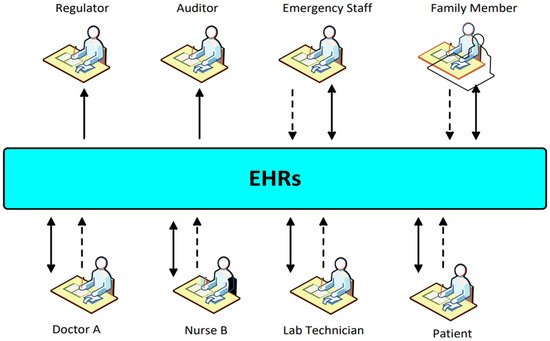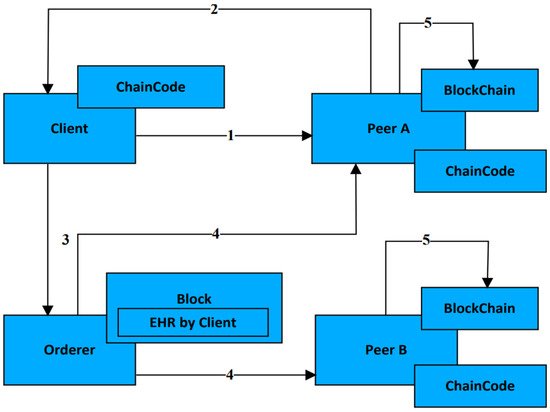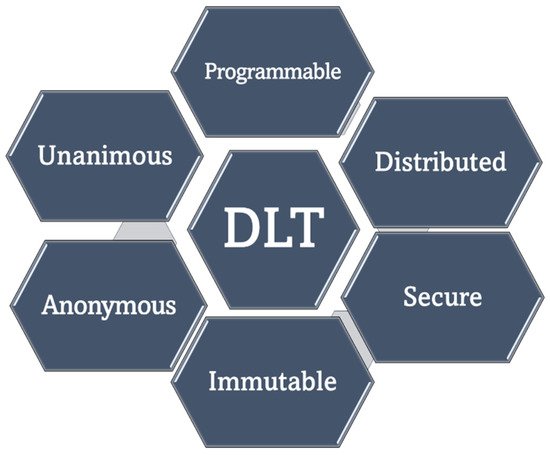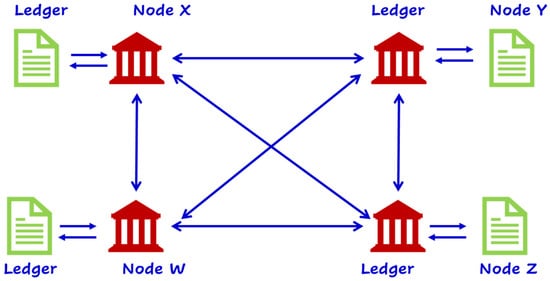The emergence of blockchain technology makes it possible to address disparate distributed system security concerns in formerly ridiculous practices. A key factor of this ability is the decentralization of the symmetrically distributed ledgers of blockchain. Such decentralization has replaced several security functionalities of centralized authority with the use of cryptographic systems. That is, public or asymmetric cryptography is the key part of what makes blockchain technology possible. Recently, tThe blockchain experience introduces the chance for the healthcare field to implement these knowhows in their electronic records. This adoption supports retaining and sharing the symmetrical patient records with the appropriate alliance of hospitals and healthcare providers in a secure decentralized system, using asymmetric cryptography like hashing, digitally signed transactions, and public key infrastructure. These include specialized applications for drug tracking, applications for observing patients, or Electronic Health Records (EHR). Therefore, it is essential to notice that the principled awareness of the healthcare professionals is the leading point of the right perception ethics.
- healthcare
- blockchain
- symmetric ledgers
- asymmetric cryptography
- integrity
1. Introduction
1.1. Blockchain Principles
1.2. Symmetric Decentralized Ledgers of Blockchain
1.3. Asymmetric Cryptography in the Blockchain

2. Related Works
| Reference | Description | Advantage | Limitations |
|---|---|---|---|
| Reegu et al. [28] | Blockchain assists in sharing health-related records among various stakeholders | The study addresses the first objective of the application of blockchain technology in healthcare sector. | It fails to address the challenges associated with blockchain technology in healthcare sector |
| Raatta et al. [7] | Application of blockchain and internet of things in healthcare and medical sector | The study addresses the first objective of the application of blockchain technology in healthcare sector. | No mention of challenges associated with blockchain technologies |
| Ullah, et al. [29] | When Internet of Things is integrated with blockchain, then it makes the entire drug traceability system to become more reliable and secure | Highlight the importance of blockchain technology in healthcare sector | No mention of challenges associated with blockchain technologies |
| Siyal, et al. [30] | Blockchain is applied to develop a kind of atmosphere where two different parties are able to trust one another. | There exist numerous ways through which blockchain can be implemented, though the common approach | No mention of challenges associated with blockchain technologies |
| Makridakis, et al. [31] | Blockchain system never poses the capability to discover and eliminate the usage of drugs that have not been authorized. | It shows security concerns that cannot be addressed by blockchain technology | No mention of the wider application of blockchain technology in healthcare industry. |
| Abunadi [32] | Blockchain is applied to develop a kind of atmosphere where two different parties are able to trust one another. | Blockchain is more transparent since one change in the transaction process will automatically get reflected for all the relevant users | It fails to address the challenges associated with blockchain technology in healthcare sector |
| Mehta [33] | Interoperability within healthcare means exchanging relevant information with each other within the entire blockchain network. | Within the healthcare industry, making sure that there is appropriate interoperability among different institutions may be a great challenge | No mention of the wider application of blockchain technology in healthcare industry. |
| Attaran [34] | Lack of trust among the patients and other groups of important stakeholders is also a major issue in the application of blockchain within the healthcare system. | The study addresses the second objective on the challenges of the application of blockchain technology in healthcare sector. | No mention of the wider application of blockchain technology in healthcare industry. |
| Reegu [35] | Despite the fact that cloud sharing usually makes it easy and convenient to transfer medical images, subsequently improving and streamlining overall patient care, the major stumbling block to the widespread usage is still fear as well as unease regarding the technology | There are a number of issues and concerns regarding the storage and sharing of relevant medical images | No mention of the wider application of blockchain technology in healthcare industry. |
| This work | It seeks to establish methods for preserving security and privacy while implementing blockchain technology in the healthcare sector. It is important for the designers of the blockchain technologies as well as the common users as it outlines the manners in which the security and privacy of the persons involved can be assured even as the technology continues to gain widespread usage and application in healthcare setups. | ||
3. Current Issues in the Healthcare Sector and How Blockchain Can Help in Addressing them
4. Application of Blockchain within the Healthcare System
4.1. Drug Traceability
4.2. Electronic Health Record


References
- Alammary, A.; Alhazmi, S.; Almasri, M.; Gillani, S. Blockchain-based applications in education: A systematic review. Appl. Sci. 2019, 9, 2400.
- Rocha, G.d.S.R.; de Oliveira, L.; Talamini, E. Blockchain applications in agribusiness: A systematic review. Future Internet 2021, 13, 95.
- Agbo, C.C.; Mahmoud, Q.H.; Eklund, J.M. Blockchain technology in healthcare: A systematic review. Healthcare 2019, 7, 56.
- Reegu, F.A.; Mohd, S.; Hakami, Z.; Reegu, K.K.; Alam, S. Towards trustworthiness of electronic health record system using blockchain. Ann. Rom. Soc. Cell Biol. 2021, 25, 2425–2434.
- Makridakis, S.; Christodoulou, K. Blockchain: Current challenges and future prospects/applications. Future Internet 2019, 11, 258.
- Alex, K.; Seema, S.; Subrata, C. Security and Privacy Challenges in Blockchain Application. In The Data-Driven Blockchain Ecosystem: Fundamentals, Applications, and Emerging Technologies; CRC Press: Boca Raton, FL, USA, 2022.
- Ratta, P.; Kaur, A.; Sharma, S.; Shabaz, M.; Dhiman, G. Application of blockchain and internet of things in healthcare and medical sector: Applications, challenges, and future perspectives. J. Food Qual. 2021, 2021, 7608296.
- Al-Haija, Q.A.; Alsulami, A.A. High Performance Classification Model to Identify Ransomware Payments for Heterogeneous Bitcoin Networks. Electronics 2021, 10, 2113.
- Abbas, A.; Alroobaea, R.; Krichen, M.; Rubaiee, S.; Vimal, S.; Almansour, F.M. Blockchain-assisted secured data management framework for health information analysis based on Internet of Medical Things. Pers. Ubiquitous Comput. 2021, 1–14.
- Dutta, P.; Choi, T.-M.; Somani, S.; Butala, R. Blockchain technology in supply chain operations: Applications, challenges and research opportunities. Transp. Res. Part E Logist. Transp. Rev. 2020, 142, 102067.
- Mettler, M. Blockchain technology in healthcare: The revolution starts here. In Proceedings of the 2016 IEEE 18th International Conference on E-Health Networking, Applications and Services (Healthcom), Munich, Germany, 14–17 September 2016; pp. 1–3.
- Ahram, T.; Sargolzaei, A.; Sargolzaei, S.; Daniels, J.; Amaba, B. Blockchain technology innovations. In Proceedings of the 2017 IEEE Technology & Engineering Management Conference (TEMSCON), Santa Clara, CA, USA, 8–10 June 2017; pp. 137–141.
- Crosby, M.; Pattanayak, P.; Verma, S.; Kalyanaraman, V. Blockchain technology: Beyond bitcoin. Appl. Innov. 2016, 2, 71.
- Michael, C.; Nachiappan, P.P.; Sanjeev, V.; Vignesh, K. Blockchain Technology: Beyond Bitcoin. Applied Innovation Review. Available online: https://www.appliedinnovationinstitute.org/blockchain-technology-beyond-bitcoin/ (accessed on 1 June 2022).
- Kaci, A.; Rachedi, A. Toward a machine learning and software defined network approaches to manage miners’ reputation in blockchain. J. Netw. Syst. Manag. 2020, 28, 478–501.
- Abu Al-Haija, Q.; Smadi, A.A.; Allehyani, M.F. Meticulously Intelligent Identification System for Smart Grid Network Stability to Optimize Risk Management. Energies 2021, 14, 6935.
- Nabben, K. Blockchain security as “people security”: Applying sociotechnical security to blockchain technology. Front. Comput. Sci. 2021, 62, 599406.
- Dubey, R.; Gunasekaran, A.; Bryde, D.J.; Dwivedi, Y.K.; Papadopoulos, T. Blockchain technology for enhancing swift-trust, collaboration and resilience within a humanitarian supply chain setting. Int. J. Prod. Res. 2020, 58, 3381–3398.
- Manski, S.; Bauwens, M. Reimagining new socio-technical economics through the application of distributed ledger technologies. Front. Blockchain 2020, 2, 29.
- Sunyaev, A. Distributed ledger technology. In Internet Computing; Springer: Berlin/Heidelberg, Germany, 2020; pp. 265–299.
- Guo, H.; Yu, X. A Survey on Blockchain Technology and its security. Blockchain Res. Appl. 2022, 3, 100067.
- Justinia, T. Blockchain technologies: Opportunities for solving real-world problems in healthcare and biomedical sciences. Acta Inform. Med. 2019, 27, 284.
- Patel, V. A framework for secure and decentralized sharing of medical imaging data via blockchain consensus. Health Inform. J. 2019, 25, 1398–1411.
- Pillai, B.; Biswas, K.; Muthukkumarasamy, V. Cross-chain interoperability among blockchain-based systems using transactions. Knowl. Eng. Rev. 2020, 35, e23.
- Bigini, G.; Freschi, V.; Lattanzi, E. A review on blockchain for the internet of medical things: Definitions, challenges, applications, and vision. Future Internet 2020, 12, 208.
- Rahmani, M.K.I.; Shuaib, M.; Alam, S.; Siddiqui, S.T.; Ahmad, S.; Bhatia, S.; Mashat, A. Blockchain-Based Trust Management Framework for Cloud Computing-Based Internet of Medical Things (IoMT): A Systematic Review. Comput. Intell. Neurosci. 2022, 2022, 9766844.
- Sharma, A.; Kaur, S.; Singh, M. A comprehensive review on blockchain and Internet of Things in healthcare. Trans. Emerg. Telecommun. Technol. 2021, 32, e4333.
- Reegu, F.A.; Al-Khateeb, M.O.; Zogaan, W.A.; Al-Mousa, M.R.; Alam, S.; Al-Shourbaji, I. Blockchain-based framework for interoperable electronic health record. Ann. Rom. Soc. Cell Biol. 2021, 30, 6486–6495.
- Nazir, S.; Ali, Y.; Ullah, N.; García-Magariño, I. Internet of things for healthcare using effects of mobile computing: A systematic literature review. Wirel. Commun. Mob. Comput. 2019, 2019, 5931315.
- Bamakan, S.M.H.; Moghaddam, S.G.; Manshadi, S.D. Blockchain-enabled pharmaceutical cold chain: Applications, key challenges, and future trends. J. Clean. Prod. 2021, 302, 127021.
- Makridakis, S.; Polemitis, A.; Giaglis, G.; Louca, S. Blockchain: The next breakthrough in the rapid progress of AI. Artif. Intell.-Emerg. Trends Appl. 2018, 27, 10.
- Abunadi, I.; Kumar, R.L. Blockchain and business process management in health care, especially for COVID-19 cases. Secur. Commun. Netw. 2021, 2021, 2245808.
- Bindlish, S.; Chhabra, S.; Mehta, K.; Sapra, P. Blockchain in Health Care: A Review. Cyber Secur. Digit. Forensics 2022, 122, 423–430.
- Attaran, M. Blockchain technology in healthcare: Challenges and opportunities. Int. J. Healthc. Manag. 2022, 15, 70–83.
- Reegu, F.; Daud, S.M.; Alam, S. Interoperability Challenges in Healthcare Blockchain System-A Systematic Review. Ann. Rom. Soc. Cell Biol. 2021, 25, 15487–15499.
- Abunadi, I.; Kumar, R.L. BSF-EHR: Blockchain security framework for electronic health records of patients. Sensors 2021, 21, 2865.
- Mbunge, E.; Batani, J.; Gaobotse, G.; Muchemwa, B. Virtual healthcare services and digital health technologies deployed during coronavirus disease 2019 (COVID-19) pandemic in South Africa: A systematic review. Glob. Health J. 2022, 6, 102–113.
- Donawa, A.; Orukari, I.; Baker, C.E. I am scaling blockchains to support electronic health records for hospital systems. In Proceedings of the 2019 IEEE 10th Annual Ubiquitous Computing, Electronics & Mobile Communication Conference (UEMCON), New York, NY, USA, 10–12 October 2019.
- Patel, P.; Majumder, S.; Shevkar, S.; Shalu, H. EMRs with Blockchain: A Distributed Democratised Electronic Medical Record Sharing Platform. In Proceedings of the International Conference on Blockchain, Melbourne, Australia, 6–8 December 2021; pp. 16–26.
- Fatokun, T.; Nag, A.; Sharma, S. Towards a blockchain assisted patient owned system for electronic health records. Electronics 2021, 10, 580.
- Keshta, I.; Odeh, A. Security and privacy of electronic health records: Concerns and challenges. Egypt. Inform. J. 2021, 22, 177–183.
- Yaqoob, I.; Salah, K.; Jayaraman, R.; Al-Hammadi, Y. Blockchain for healthcare data management: Opportunities, challenges, and future recommendations. Neural Comput. Appl. 2021, 34, 11475–11490.
- Konapure, R.R.; Nawale, S.D. Smart Contract System Architecture for Pharma Supply chain. In Proceedings of the 2022 International Conference on IoT and Blockchain Technology (ICIBT), Ranchi, India, 6–8 May 2022; pp. 1–5.
- Sohan, M.; Al, F.A.; Khan, S.R.; Anannya, N.J.; Ahad, M.T. Towards a secured smart IoT using light weight blockchain: An aim to secure Pharmacy Products. arXiv 2022, arXiv:2206.06925.
- Kamenivskyy, Y.; Palisetti, A.; Hamze, L.; Saberi, S. A Blockchain-Based Solution for COVID-19 Vaccine Distribution. IEEE Eng. Manag. Rev. 2022, 50, 43–53.
- Kramer, M.P.; Bitsch, L.; Hanf, J.H. The Significance of Blockchain Governance in Agricultural Supply Networks. In Sustainable Agricultural Value Chain; IntechOpen: London, UK, 2022.
- Almutairi, K.; Hosseini Dehshiri, S.J.; Hosseini Dehshiri, S.S.; Hoa, A.X.; Arockia Dhanraj, J.; Mostafaeipour, A.; Issakhov, A.; Techato, K. Blockchain Technology application challenges in renewable energy supply chain management. Environ. Sci. Pollut. Res. 2022, 6, 1–18.
- Goyal, S.; Sharma, N.; Bhushan, B.; Shankar, A.; Sagayam, M. Iot enabled technology in secured healthcare: Applications, challenges and future directions. In Cognitive Internet of Medical Things for Smart Healthcare; Springer: Berlin/Heidelberg, Germany, 2021; pp. 25–48.
- Khan, S.N.; Loukil, F.; Ghedira-Guegan, C.; Benkhelifa, E.; Bani-Hani, A. Blockchain smart contracts: Applications, challenges, and future trends. Peer-Peer Netw. Appl. 2021, 14, 2901–2925.
- Kumar, T.; Kaur, S. Blockchain Technology: Present and Future Perspectives. In Applications, Challenges, and Opportunities of Blockchain Technology in Banking and Insurance; IGI Global: Hershey, PA, USA, 2022; pp. 258–265.
- Hussien, H.M.; Yasin, S.M.; Udzir, N.I.; Ninggal, M.I.H.; Salman, S. Blockchain technology in the healthcare industry: Trends and opportunities. J. Ind. Inf. Integr. 2021, 22, 100217.
- Fang, H.S.A.; Tan, T.H.; Tan, Y.F.C.; Tan, C.J.M. Blockchain personal health records: Systematic review. J. Med. Internet Res. 2021, 23, e25094.
- Arun Kumar, B. Developing Business-Business Private Block-Chain Smart Contracts Using Hyper-Ledger Fabric for Security, Privacy and Transparency in Supply Chain. In Data Management, Analytics and Innovation; Springer: Berlin/Heidelberg, Germany, 2022; pp. 429–440.
- Li, X.; Wang, Z.; Leung, V.C.; Ji, H.; Liu, Y.; Zhang, H. Blockchain-empowered data-driven networks: A survey and outlook. ACM Comput. Surv. 2021, 54, 1–38.
- Akhter Md Hasib, K.T.; Chowdhury, I.; Sakib, S.; Monirujjaman Khan, M.; Alsufyani, N.; Alsufyani, A.; Bourouis, S. Electronic health record monitoring system and data security using blockchain technology. Secur. Commun. Netw. 2022, 2022, 2366632.
- Torres-Carrión, P.V.; González-González, C.S.; Aciar, S.; Rodríguez-Morales, G. Methodology for systematic literature review applied to engineering and education. In Proceedings of the 2018 IEEE Global Engineering Education Conference (EDUCON), Canary Islands, Spain, 17–20 April 2018; pp. 1364–1373.



